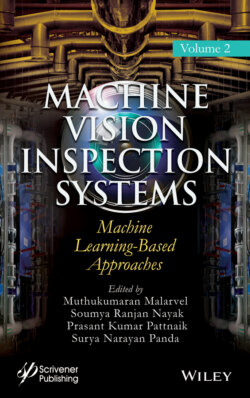Читать книгу Machine Vision Inspection Systems, Machine Learning-Based Approaches - Группа авторов - Страница 25
2.3 System Design
ОглавлениеIn this research, we define character image classification as a subproblem of character verification and develop an image verification model which learns a function F, as shown in Equation (2.1)
(2.1)
which gives the Pi,j probability of two images, Xi and Xj belonging to the same category. We expect the model to learn a general representation of images that could be applied to unseen data without any further training. After fine-tuning the model for the verification task, we use a one-shot learning approach to classify images, as explained in Section 2.3.1.
We propose a Siamese architecture comprising of a twin capsule network and a fully connected network, for character verification. This architecture mainly consists of a weight sharing twin network, vector difference layer and a fully connected network, as shown in Figure 2.1. Siamese network takes two input images, run them through a feature extraction process, comparison layers, and finally gives out the probability of belonging to the same category. Twin network starts with a convolutional layer and has four capsule layers before the fully connected entity capsule layer. Results from twin network merged using a vector difference function and input to the fully connected part to predict the final probability. We decompose the Siamese network to three main sections: Twin network, Difference layer and Fully connected network, to explain the structure and functionality.
Twin network: Twin network consists of two similar networks that share weights between them. The purpose of sharing weights is getting the same output from both networks if the same image feed to them. Since we wanted the twin network to learn how to extract features that could help distinguish images; convolutional layers, capsule layers and deep capsule layers were used and deep capsule layers-based model gave the best performance.
The capsule network consists of four layers. Since we consider relatively simpler images with plain backgrounds, having many layers has a less effect. The first layer is a convolutional layer with 256, 9 × 9 kernels with a stride 5 to discover basic features in the 2D image. Second, third, and fourth layers are capsule layers with 32 channels of 4-dimensional capsules, where each capsule consists of 4 convolutional units with a 3 × 3 kernel and strides of 2 and 1, respectively. Next capsule layer contains 16 channels of 6-dimensional capsules. Each of them consists of a convolutional unit with a 3 × 3 kernel and stride of 2. The sixth layer is a fully connected capsule layer named as entity capsule layer. It contains 20 capsules of 16-dimension. We use dynamic routing proposed by Ref. [9], between final convolutional capsule layer and entity capsule layer with three routing iterations.
Vector difference layer: After twin network identifies and extracts important features in two input images, the vector difference layer is used to compare those features to get a final decision about similarity. Each capsule in the twin network is trained to extract an exact type of property or entity such as an object or part of an object. Here, the length and the direction of the output vector is determined by the probability of feature detection and the state of the detected feature, respectively [11]. For example, when an identified feature is changed its state by a move, the probability remains the same with the vector length, while orientation changes. Due to this property, it is not enough to take scalar difference using L1 distance but needs to use more complex vector difference and analyse it. We obtain 20 vectors of dimension 16 after the difference layer and feed it to a fully connected network.
Figure 2.1 Siamese network architecture.
Fully connected network: Fully connected network comprises four fully connected layers with parameters as shown by Figure 2.1. Except for the last fully connected layer which has sigmoid activation, other fully connected layers use Rectified Linear Unit (ReLU) activation [35]. In this study, multiple fully connected layers are used to analyse the complex output of the vector difference layer to get an accurate probability.
